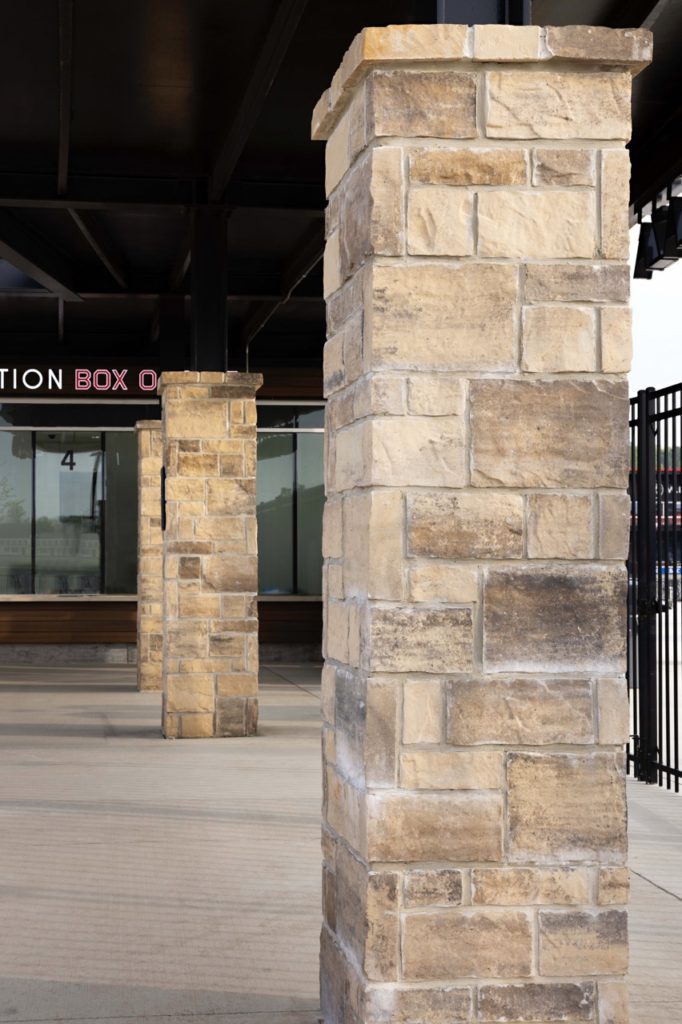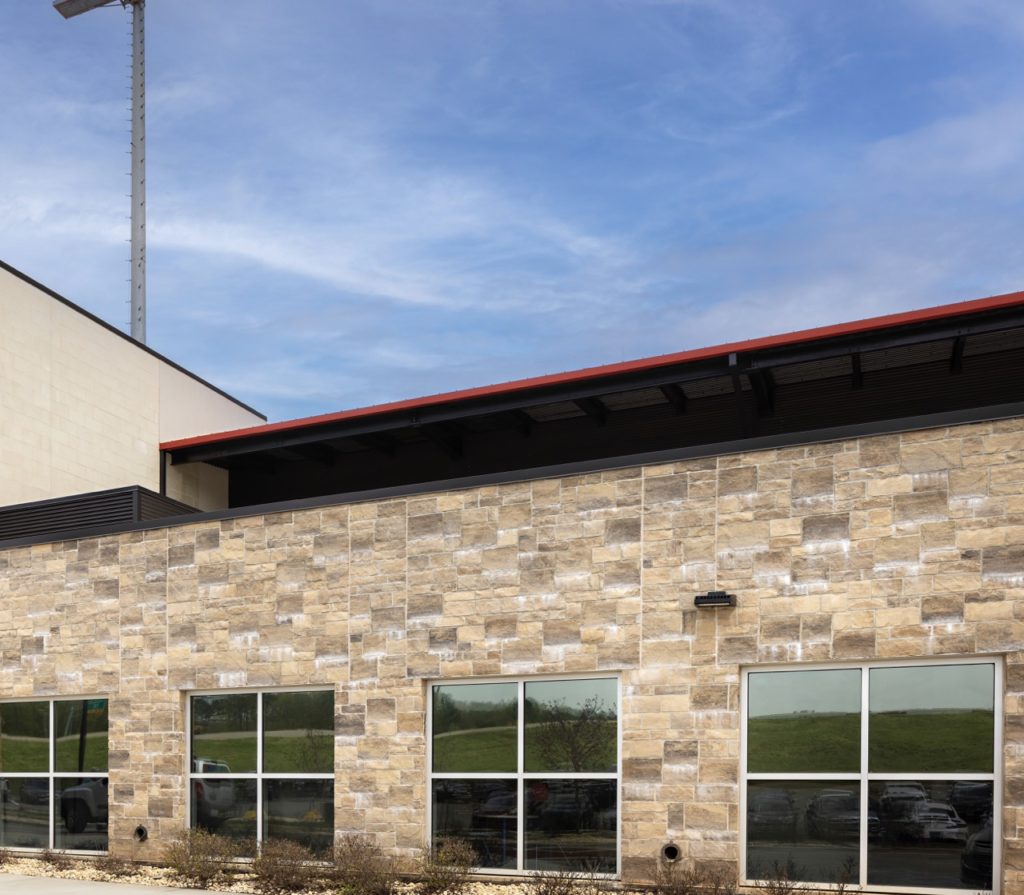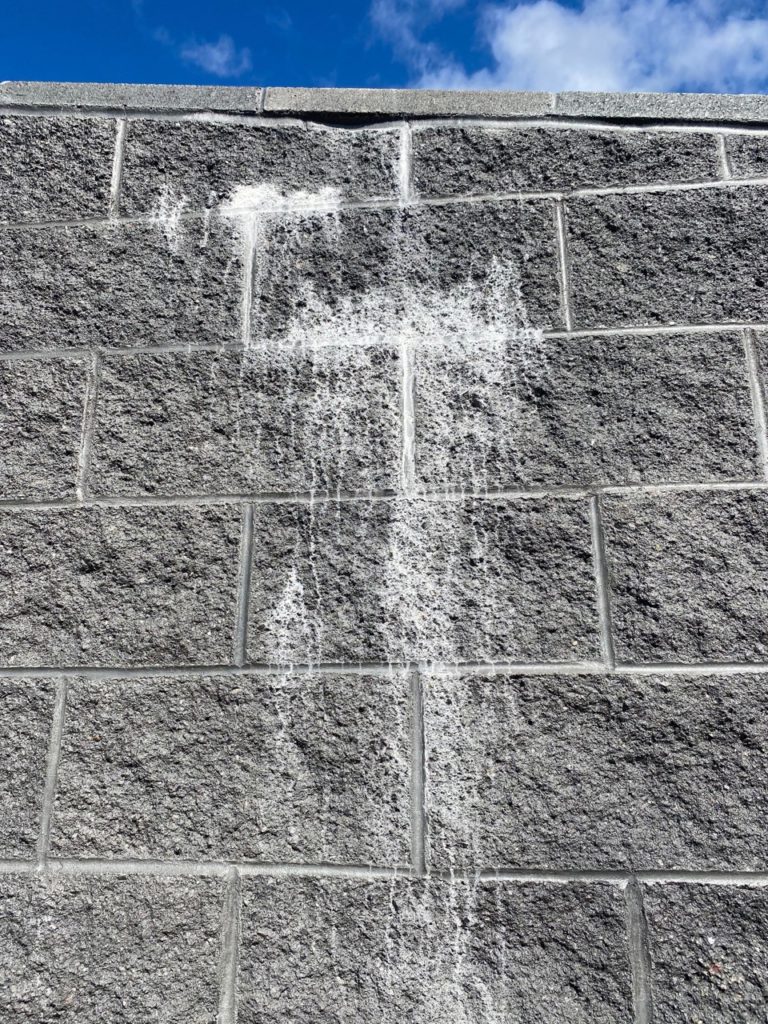Hidden Causes of Efflorescence: How to Identify, Prevent and Treat It
Words: John Cicciarelli
Words: John Cicciarelli, Director of Masonry, Oldcastle APG
Photos: Oldcastle APG
If you’ve built with masonry, you’ve battled efflorescence: the white, powdery substance that appears on the surface of masonry walls sometimes days or weeks after the job is complete. Efflorescence – or “efflo,” colloquially – is obviously unsightly, but it’s not just an aesthetic threat. Left untreated, it can also be damaging to the structure.
Luckily, there are simple guidelines to help mitigate efflorescence – and even easier best practices to help avoid it in the first place!
But first, let’s take a look at what efflorescence is.
What is Efflorescence?
Efflorescence is a crystalline deposit that forms on the surface of masonry walls. It’s composed of soluble salts that are present in almost all cementitious building materials. When these materials come into contact with water, the salts dissolve and are carried to the surface of the wall, where they dry and form the powdery substance we call efflorescence.
That water can come from a variety of sources. Some you can control, like building tight walls that reduce moisture intrusion. Some you can’t control, like water introduced naturally during a rainstorm, in high-humidity areas, or regions with high groundwater levels.
Jake Boyer, head of PROSOCO’s Clean and Protect division, knows a thing or two about efflorescence. “If it's raining or a building is being washed, capillary action grabs that moisture and pulls it into the dry masonry substrate, breaking down the soluble salts on the way,” explains Boyer.
“When the rain stops, the capillary action reverses because now it's drier on the outside of the substrate. That moisture is now carrying dissolved salts. So when it evaporates on the surface of the wall, the salts are left behind – and that’s what we call an efflorescence bloom.”
Know The Difference: Efflorescence vs. Lime Run
“People commonly refer to just about any white stain on the wall as efflorescence,” Boyer says. “By definition of the word, that may be technically accurate, but oftentimes, those stains may have a different composition than what is commonly known as efflorescence.”
“When we’re talking 'efflorescence,' more often than not, we’re talking about that white powdery stuff on the wall. But that similar white look can also be created by lime run, which must be treated differently.”
 Efflorescence
Efflorescence Lime Run
Lime Run
Lime run is mobilized by water in the same way as efflorescence, but it’s actually a result of the free calcium hydroxide, or lime (which is natural to many masonry substrates – that’s moving to the surface.
“When calcium hydroxide is deposited on the surface of a masonry wall, it goes through a carbonation process where it reacts with the atmospheric carbon dioxide, rendering it no longer water-soluble,” Boyer explains. “In other words, you get a crusty buildup that becomes as hard as a rock, literally
Since common efflorescence remains water-soluble, a water prewet, followed by some assistance from a chemical cleaner and a thorough rinsing, will typically dissolve and break those salts down to clean them off the wall. Lime run – aka calcium carbonate, becomes more resilient than the substrate that it's attached to. Often a cleaner that’s aggressive enough to dissolve the lime run can also damage the underlying substrate.
“A good way to identify what you’re dealing with, is to splash water on the surface. If it removes or has any visual impact to the stain itself, it’s likely common efflorescence. If it doesn't disappear and there's no visual change, it’s probably lime run,” says Boyer.
Regardless of whether you’re dealing with traditional efflorescence or the more aggressive lime run, mitigation is critical. Left untreated, both salt (sodium chloride) and lime run (calcium carbonate) can damage the underlying masonry, shortening its lifespan and causing further deterioration.
So You’ve Got Efflo…Cleaning and Treatment Options
When dealing with any staining on masonry, always take the approach of using the mildest cleaning product and application method first. Starting with test areas – ideally mockup walls – can help determine the best cleaners and methods for each unique scenario.
Whether it’s simple efflorescence or lime run, it’s important to determine what the appropriate product dilution and application method are first, before applying any cleaning products to a larger area.
“In masonry cleaning, my number one rule is always to first, do no harm,” Boyer says. “So always take the mildest approach first and incrementally get more aggressive as necessary to find the right combination.”
While cleaning is a good after-the-fact solution, once efflo starts, the damage is often done. Therefore, the ideal solution is simple: control moisture more effectively.
The good thing about efflorescence is that it can alert you to moisture penetration issues that may have otherwise gone unnoticed -- so it can be addressed before the damage becomes more severe. In order to prevent efflorescence before it occurs, or prevent recurrence once it has been removed, the simplest solution is to control moisture more effectively by following good design and construction practices.
Efflorescence Prevention 101
Efflorescence requires three items to form, each of which can be controlled to a degree.
- The actual salts themselves, inherent in masonry and mortar
- Water to make those salts soluble, and
- A pathway or pores to allow the salty water to be carried to the surface.
Disrupting just one of these root causes will significantly mitigate efflo formation and keep your walls standing strong.
- Mitigate Unnecessary Moisture: Keep stored materials off the ground and covered so they’re not susceptible to rainwater.
- Keep the Installation Dry: During the job, cover the top of the wall at the end of the day, especially if rain is in the forecast.
- Proper Design Techniques: Condition the space between floors to reduce pressure differentials that can wick moisture – especially in tall walls and multi-story structures. An effective air and weather barrier can help manage this as well. Design the wall with a cap, whether metal, masonry or other materials that extends beyond the face of the wall and has a drip edge to prevent water from running back to the wall. Design with other water shedding features in mind such as eaves, cornices, or other water shedding features.
- Proper Construction Techniques: Permanently cap the wall with the appropriate materials as soon as possible. Be sure to completely fill all head and bed joints, and tool those joints to a smooth surface. Then, be sure to conduct your final clean down with the appropriate products and methods per the manufacturers’ product data sheet.
- Treat the Substrate: After the wall is cleaned and thoroughly dry, apply a penetrating protective treatment to mitigate moisture intrusion from the exterior.
With protective treatments, the best options are typically comprised of silane, siloxane, or some silicones. “Often it’s a combination of just one, two or even all three of these,” says Boyer. Penetrating water repellents should also allow the masonry to breathe. Film-forming barriers can cause efflorescence, or even worse, sub-fluorescence issues of their own. “It’s important to ensure the wall maintains its natural rate of water vapor transmission to promote drying before mobilizing these stains.”
 Efflorescence
Efflorescence Lime Run
Lime Run
Integral Water Repellents: The “Belt & Suspenders” Approach
While post-applied protective treatments can be effective in controlling efflo, and many other common stains, they shouldn’t be looked to as the magic bullet to compensate for poor design and construction practices.
- Application Consistency: Protective treatments have application guidelines that must be followed for proper performance. Apply too thin of a layer or miss an area and moisture won’t be blocked – opening up an efflo opportunity.
- UV Breakdown & Reapplication Requirements: While penetrating protective treatments work within the pore structure and beneath the surface that’s most severely affected by UV, post-applied protective treatments may not last the entire lifetime of a building. Re-application may be required to effectively prevent water penetration and subsequent efflorescence formation in the long run.
The most effective way to eliminate moisture is to utilize both an integral water repellent that’s added to your masonry units and your mortar at the point of manufacture or on site, AND a post-construction-applied penetrating protective treatment as a belt and suspenders approach.
The integral water repellent (IWR) solution delivers an internal shield against moisture throughout the interior of the wall, and the post-applied penetrating protective treatment further protects bulk water from entering the exterior of the masonry unit as well as the entire mortar joint. No other solution can provide that level of protection and quality assurance.
It’s important to note that IWRs need to be added to BOTH the block and mortar in order to be effective. Leaving either untreated means that there’s a vector for moisture intrusion and efflo formation.
On the cutting edge of IWRs technology, there are options that include “tracers” that can be detected via core sample to verify that the water repellent has been properly integrated. Many masons have embraced this technology as it can help absolve them of responsibility for any post-installation issues.
Taken together, all of these steps – from designing and building with quality masonry and mortar products, to cleaning and protecting the masonry wall – will result in putting the structure’s best face forward. A clean, efflo-free wall means stronger, longer-lived structures, happier customers, and fewer headaches for your team of masons.
About the Author
John Cicciarelli serves as Director of Masonry at Oldcastle APG where he supports the sales and marketing efforts for Echelon Masonry and all of the Oldcastle APG companies. He began his career with Oldcastle in 1998 as an architectural sales manager for the West Region. Since then he has served as Plant Manager, a Regional Sales Manager, and several roles at the Oldcastle corporate level in Atlanta for the past 14 years.